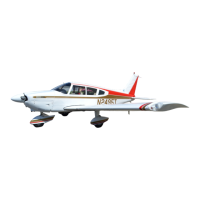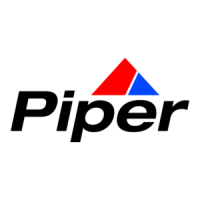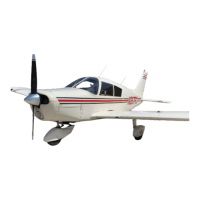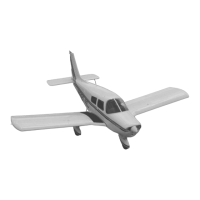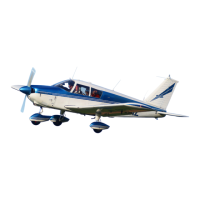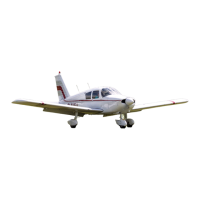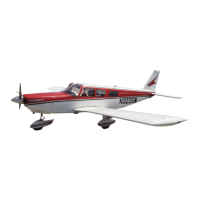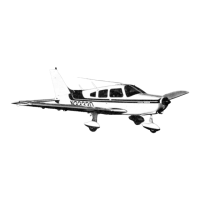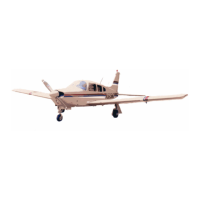Do you have a question about the Piper CHEROKEE 180 C and is the answer not in the manual?
Details on aircraft performance metrics like speed, climb rate, and ceilings.
Specifies gross weight, empty weight, and useful load of the aircraft.
Information on the engine, its specifications, and propeller details.
Capacity and grade of fuel and oil required for the aircraft.
Details on baggage capacity and door dimensions.
Key physical dimensions like wing span, length, and height.
Specifications for the landing gear, including wheel size and tire pressure.
Describes the engine model, horsepower, and propeller type.
Details on the aircraft's construction materials and wing airfoil.
Describes the landing gear components, steering, and brake system.
Explains the aircraft's flight control systems, including surfaces and trim.
Details fuel tank capacity, pump operation, and fuel quantity indication.
Covers the aircraft's electrical components, alternator, battery, and ammeter usage.
Describes the cabin heating, defrosting, and ventilation airflow.
Outlines interior features like instrument panel layout, seats, and baggage access.
Step-by-step guide for pre-flight inspection of the aircraft.
Procedures for starting the aircraft engine, including priming.
Guidelines for warming up the engine after starting.
Procedures for checking engine operation and gauges on the ground.
Instructions and techniques for performing a safe take-off.
Recommended speeds and procedures for climbing.
Information on stall speeds in different configurations and bank angles.
Guidance on cruising speeds, power settings, and mixture leaning.
Procedures and considerations for approaching and landing the aircraft.
Steps for safely shutting down the engine after landing.
Procedures to follow in case of engine power loss.
Instructions for moving and securing the aircraft on the ground.
Emphasizes pilot responsibility for proper loading and CG.
Useful advice for operating the aircraft efficiently and safely.
Overview of emergency procedures and their importance.
Actions to take if the engine loses power during takeoff.
Procedures for handling engine power loss while airborne.
Steps for executing a landing without engine power.
Procedures for dealing with electrical or engine fires.
Actions to take in case of low or no oil pressure.
Steps to address fuel pressure issues.
Response to abnormally high oil temperature indications.
Procedures for dealing with alternator failure.
Troubleshooting engine roughness, likely due to icing.
Recovery procedures for inadvertent spins.
Instructions for closing a cabin door in flight.
Chart to convert temperature and pressure altitude to density altitude.
Graph showing takeoff distance based on density altitude.
Graph illustrating rate of climb at different density altitudes.
Chart showing aircraft range at various density altitudes and power settings.
Graph relating true airspeed and engine RPM to density altitude.
Graph showing landing distance based on density altitude.
Table indicating engine RPM for various power settings and altitudes.
Introduction to minor maintenance tasks and where to find further assistance.
Procedures for servicing landing gear struts and wheels.
Information on checking and maintaining the hydraulic brake system.
Recommended tire pressures for optimal service and safety.
Recommended procedures for cleaning and maintaining aircraft windows.
Guidance on checking battery fluid level and charge state.
Specifies the minimum octane fuel grade required for the engine.
Details oil capacity and recommended change intervals.
Instructions for cleaning the fuel strainer.
Maintenance schedule for the carburetor air filter.
Procedures for leveling the aircraft and checking flight surface rigging.
Location and purpose of the aircraft's serial number plate.
Reference to the original flight manual.
Details on aircraft performance metrics like speed, climb rate, and ceilings.
Specifies gross weight, empty weight, and useful load of the aircraft.
Information on the engine, its specifications, and propeller details.
Capacity and grade of fuel and oil required for the aircraft.
Details on baggage capacity and door dimensions.
Key physical dimensions like wing span, length, and height.
Specifications for the landing gear, including wheel size and tire pressure.
Describes the engine model, horsepower, and propeller type.
Details on the aircraft's construction materials and wing airfoil.
Describes the landing gear components, steering, and brake system.
Explains the aircraft's flight control systems, including surfaces and trim.
Details fuel tank capacity, pump operation, and fuel quantity indication.
Covers the aircraft's electrical components, alternator, battery, and ammeter usage.
Describes the cabin heating, defrosting, and ventilation airflow.
Outlines interior features like instrument panel layout, seats, and baggage access.
Step-by-step guide for pre-flight inspection of the aircraft.
Procedures for starting the aircraft engine, including priming.
Guidelines for warming up the engine after starting.
Procedures for checking engine operation and gauges on the ground.
Instructions and techniques for performing a safe take-off.
Recommended speeds and procedures for climbing.
Information on stall speeds in different configurations and bank angles.
Guidance on cruising speeds, power settings, and mixture leaning.
Procedures and considerations for approaching and landing the aircraft.
Steps for safely shutting down the engine after landing.
Procedures to follow in case of engine power loss.
Instructions for moving and securing the aircraft on the ground.
Emphasizes pilot responsibility for proper loading and CG.
Useful advice for operating the aircraft efficiently and safely.
Overview of emergency procedures and their importance.
Actions to take if the engine loses power during takeoff.
Procedures for handling engine power loss while airborne.
Steps for executing a landing without engine power.
Procedures for dealing with electrical or engine fires.
Actions to take in case of low or no oil pressure.
Steps to address fuel pressure issues.
Response to abnormally high oil temperature indications.
Procedures for dealing with alternator failure.
Troubleshooting engine roughness, likely due to icing.
Recovery procedures for inadvertent spins.
Instructions for closing a cabin door in flight.
Chart to convert temperature and pressure altitude to density altitude.
Graph showing takeoff distance based on density altitude.
Graph illustrating rate of climb at different density altitudes.
Chart showing aircraft range at various density altitudes and power settings.
Graph relating true airspeed and engine RPM to density altitude.
Graph showing landing distance based on density altitude.
Table indicating engine RPM for various power settings and altitudes.
Introduction to minor maintenance tasks and where to find further assistance.
Procedures for servicing landing gear struts and wheels.
Information on checking and maintaining the hydraulic brake system.
Recommended tire pressures for optimal service and safety.
Recommended procedures for cleaning and maintaining aircraft windows.
Guidance on checking battery fluid level and charge state.
Specifies the minimum octane fuel grade required for the engine.
Details oil capacity and recommended change intervals.
Instructions for cleaning the fuel strainer.
Maintenance schedule for the carburetor air filter.
Procedures for leveling the aircraft and checking flight surface rigging.
Location and purpose of the aircraft's serial number plate.
Reference to the original flight manual.
| Manufacturer | Piper Aircraft |
|---|---|
| Model | CHEROKEE 180 C |
| Engine | Lycoming O-360-A4A |
| Horsepower | 180 hp |
| Seating | 4 |
| Type | Light aircraft |
| Fuel Capacity | 50 US gal (190 L) |
